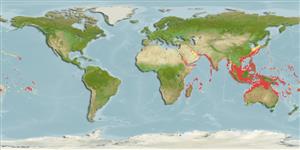Environment: milieu / climate zone / depth range / distribution range
Ecologia
marino; salmastro associati a barriera corallina; distribuzione batimetrica 2 - 178 m (Ref. 86942), usually 15 - 75 m (Ref. 9710). Tropical; 30°N - 35°S
Indo-Pacific: East Africa and Persian Gulf to the Society Islands, north to southern Japan, south to Lord Howe Island. Throughout Micronesia.
Size / Peso / Age
Maturity: Lm ? range ? - ? cm
Max length : 25.0 cm TL maschio/sesso non determinato; (Ref. 5372); common length : 15.0 cm TL maschio/sesso non determinato; (Ref. 5450)
Spine dorsali (totale): 11 - 12; Raggi dorsali molli (totale): 22-27; Spine anali 3; Raggi anali molli: 17 - 19.
Inhabit deep, protected lagoons and channels, and the deeper parts of outer reef slopes. Juveniles are often solitary while adults occur in pairs (Ref. 1602, 48636). A planktivorous species that generally remains within a few meters of the reef. Juveniles may sometimes pick on parasites on the epidermis of other fish (Ref. 5503). Oviparous (Ref. 205). Form pairs during breeding (Ref. 205).
Life cycle and mating behavior
Maturità | Riproduzione | Deposizione | Uova | Fecundity | Larve
Form pairs during breeding (Ref. 205).
Steene, R.C., 1978. Butterfly and angelfishes of the world. A.H. & A.W. Reed Pty Ltd., Australia. vol. 1. 144 p. (Ref. 4859)
IUCN Red List Status (Ref. 130435)
Threat to humans
Harmless
Human uses
Pesca: scarso interesse commerciale; Acquario: Commerciale
Strumenti
Special reports
Download XML
Fonti Internet
Estimates based on models
Preferred temperature (Ref.
123201): 23.6 - 29.1, mean 27.9 °C (based on 2680 cells).
Phylogenetic diversity index (Ref.
82804): PD
50 = 0.5039 [Uniqueness, from 0.5 = low to 2.0 = high].
Bayesian length-weight: a=0.02291 (0.01452 - 0.03614), b=3.04 (2.90 - 3.18), in cm total length, based on LWR estimates for this species & (Sub)family-body (Ref.
93245).
Trophic level (Ref.
69278): 3.8 ±0.37 se; based on food items.
Resilienza (Ref.
120179): Alto, tempo minimo di raddoppiamento della popolazione meno di 15 mesi (Preliminary K or Fecundity.).
Fishing Vulnerability (Ref.
59153): Low vulnerability (15 of 100).
Nutrients (Ref.
124155): Calcium = 65 [32, 111] mg/100g; Iron = 0.654 [0.391, 1.110] mg/100g; Protein = 19 [18, 20] %; Omega3 = 0.148 [0.089, 0.254] g/100g; Selenium = 41.9 [21.5, 82.0] μg/100g; VitaminA = 44.9 [11.8, 164.4] μg/100g; Zinc = 1.27 [0.85, 1.82] mg/100g (wet weight);
